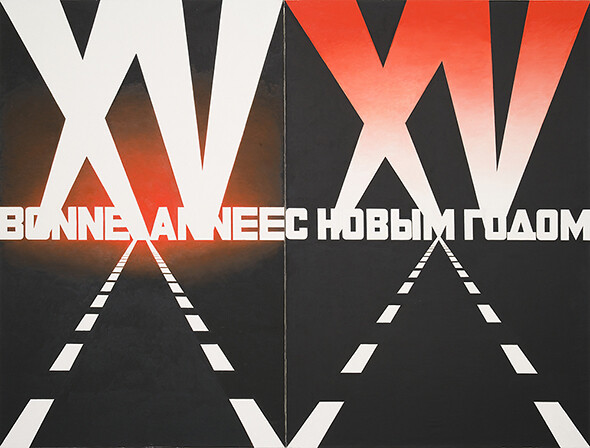March 17–May 7, 2016
SKOPIA / P.-H. Jaccaud
9, Vieux-Grenadiers
CH-1205 Geneva
T +41 22 321 61 61
info [at] skopia.ch
www.skopia.ch
The life and career of Erik Bulatov reflect the numerous upheavals of European and world history. Born in the USSR in 1933, Bulatov studied Plastic Arts at the School of Fine Arts in Moscow from 1947 to 1952, and subsequently at the Surikov Institute. Although his talent was recognised at an early stage, Erik Bulatov soon deviated from the Soviet artistic model and was forced to forgo the advantages of an academic career. He developed a highly personal style in defiance of official artistic canons. He was forbidden to exhibit and attempts to present his work were stopped by the police. Bulatov managed to survive this period by illustrating children’s books, at the same time staying up-to-date with artistic developments in the West and exchanging perspectives with other leading artists such as Ilya Kabakov.
In 1988, the Kunstmuseum in Bern presented Ich lebe – ich sehe, an exhibition uniting non-comformist Soviet artists, among whom Bulatov, Kabakov, Vladimir Yankilevsky and Oleg Vassiliev were included. This exhibition represented a decisive turning point in Bulatov’s artistic career. Shortly after, a major personal exhibition travelled through Europe and the United States, stopping at institutions such as the Kunsthalle Zurich, the ICA London or the Centre Pompidou. In 2006, the Kestner Gesellschaft in Hanover organised a large-scale retrospective of his work. The second installment of this exhibition, presented at the Tretyakov Gallery in Moscow the same year was a huge success. Art critics, collectors, institutions, the public, and, in particular, young artists, all hailed Bulatov as one of the most important living Russian artists. Later, the Mamco in Geneva (2009), the Nouveau musée national of Monaco (2013), the Manège (2014) and the Garage (2015) in Moscow have shown important retrospectives.
Bulatov has developed a unique style, at the same time hyperrealistic and conceptual, combining landscapes and monumental inscriptions, questioning the boundaries of the image and of art itself. The issue of the picture is at the heart of his research: this notion is for him more important than that of painting as such. Time, space, light, language, break through the canvas and participate in a dynamic quest for freedom. “For me, the picture represents a model of the universe. Its place is between me and this exterior world […]“, says the artist. Whether it be a landscape, strollers along a boulevard or poetry in immense Cyrillic letters piercing the sky of the canvas, Bulatov transcends each theme. Everything—the question, the response, the mystery—happens not on the surface of the image but inside the picture and nowhere else. The latter is the only tangible reality for the artist, the one binding social space to the space of the canvas, the question of freedom becoming thus a spatial problem.


